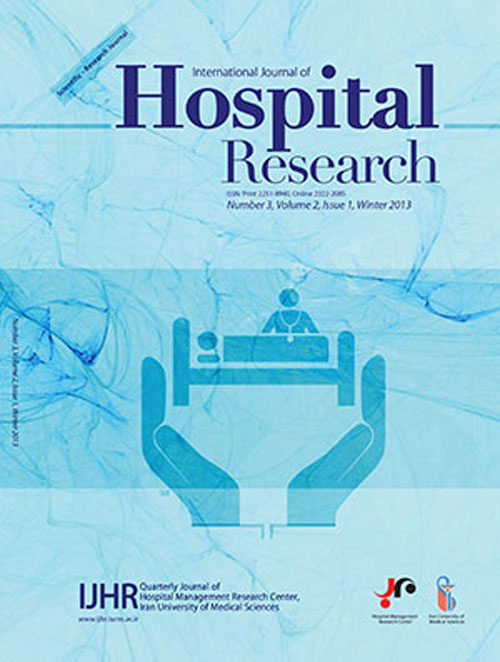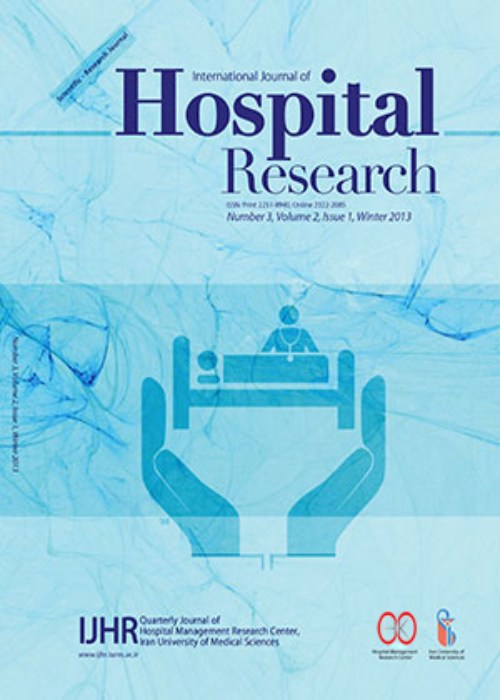فهرست مطالب

International Journal of Hospital Research
Volume:5 Issue: 1, Winter 2016
- تاریخ انتشار: 1394/12/20
- تعداد عناوین: 7
-
-
Page 1Background And ObjectivesHealth care workers are under constant exposure to the risk of ooccupational blood-borne infection, which most of the time can be avoided by observing standard precautions. The aim of this study was to assess the knowledge, attitude and practices of health care workers of a sample tertiary care hospital towards occupational exposure to blood-borne pathogens.MethodsA cross sectional study was carried out among health care workers of a 2500 bedded tertiary care hospital. The study instrument was structured and pretested questionnaire designed to measure the knowledge, attitude and practices of the participants towards occupational exposure.
Findings: Among the 380 respondents 22.63% gave history of sustaining NSI in the preceding 1 year. The commonest clinical activity to cause NSI among doctors was blood sampling (37.5%) followed by re-capping of needles (31.3%). Although 70.5% of the participants were aware of the immediate step to be followed after NSI, only 47.36% gave partial correct answer to the questions regarding the number of diseases transmitted by NSI, and 44.2% had the correct knowledge about the Post Exposure Prophylaxis (PEP) facilities available in the hospital.ConclusionsThe prevention of transmission of blood-borne pathogens among health care workers requires an education-centric approach and a comprehensive infection control protocol along with strict compliance with the practices within the health care delivery system.Keywords: Health care workers, Needle, stick injuries, Blood, borne infection, Occupational risk -
Page 7Background And ObjectivesThe use of Magnetic Resonance Imaging (MRI) systems is on the rise and the number of installed systems is constantly increasing all over the world. This raises the possibility for emergency personnel to get in contact with these systems. However, the clothing and working material of paramedics and firefighters is not designed for the use on magnets. More research is needed to gain a deeper understanding of the risks for emergency personnel, working on MRI systems. Therefore, this study examined the effects of magnetic force on selected working materials and clothes of firefighters and paramedics.MethodsThis study was conducted as a field study, utilising a 1.5 tesla MRI system. Selected items were examined on their behavior in the magnetic field and the following parameters were measured: (i) the force of attraction and (ii) the distance to the magnet when a force of attraction is recognisable. Manual force meter and a wooden distance meter were used to measure the parameters.
Findings: The highest force of attraction can be researched in helmets (30 newton), boots (90 newton) and gloves (17 newton). The measured force is high enough to pull these items into the magnet. Jackets and pants did not receive a high force of attraction. Working material can be influenced by eddy currents, according to the composition. The movement of the item can then be restricted.ConclusionsConsidering the results of this study, most of the clothing and working materials can be considered as MRI safe. However, the force of attraction of boots and helmets might be high enough to cause serious distraction for emergency personnel. There might be a high risk for emergency personnel to forget small items in their pockets which subsequently can act as dangerous projectiles. Additional tests might display the need for an independent MRI system. There is a high risk to damage the system (e.g. to break the cover by attracted objects) and hospitals might not be willing to take the risk in the future.Keywords: Magnetic Resonance Imaging, Safety, Magnetic Fields, Firefighters, Paramedics, Emergencies -
Page 13Background And ObjectivesMonitoring of health organizations by the regulatory bodies is crucial to ensure high performance of health system. Although Iranian health settings are monitored by the MOHME in various ways, periodic evaluation of their continuous commitment to the national licensure standards in health domain is rare. The aim of the present study was to highlight the important of such evaluations by auditing the general health clinics of Tabriz (a metropolitan city in Northwestern Iran) based on national licensure standards.MethodsThis across-sectional study surveyed all general health settings in Tabriz city. The data were collected using a validated researcher-made checklist. The collected data were summarized using descriptive statistical methods. The mean values were compared by t-test and ANOVA.
Findings: The score of compliance to national licensure standards averaged at 70.5%. The highest level of compliance was observed for medical and non-medical devices dimension (78.2%) whereas the loest compliance was recorded for hygiene dimension (58.4%). Public clinics showed a significantly higher compliance to standards compared to the private settings (P andConclusionsThe level of current compliance of the surveyed clinical settings shows room for considerable improvement. Private health settings and the hygiene domain are the primary targets of focus for monitoring and intervention. Our results encourage further national-wide studies to gain a comprehensive view of the compliance of Iranian clinics to the licensure standards.Keywords: Licensure, Hospital, Benchmarking, Clinical audit, Health system -
Page 17Background And ObjectivesIn the most Iranian hospitals the internal air is cooled by a system comprising centrifugal blower fan and excelsior filters. Because amoeba can be present in air and dust it may enter into filters of cooling systems. It has been suggested that diffusion of amoebae cyst through air canals may contribute to various types of nosocomial infections. This study thus aimed to examine the possible contamination of filters of the conventional hospital cooling systems with free-living amoebae.MethodsEighty four cooling systems from four hospitals in Arak City (Central Iran) were sampled. Samples were cultured in defined medium and were tested from presence of Acanthamoeba spp.
Findings: Ten out of the 18 hospital wards/sites and 23 out of 84 cooling systems surveyed (27.3%) were found to be contaminated by amoebae.ConclusionsOur results indicate a significant level of amoebae cysts contamination of cooling systems with excelsior filters in various hospital wards. Given the potential contribution of cyst to nosocomial infection, a prompt addressing of the problem is warranted. This may partly be accomplished by using non-aqueous or closed circulation cooling systems. Our study also highlights the need for similar investigations in other health settings and in larger scales to gain insight into the extent of the problem and the associated risks.Keywords: Nosocomial infection, Patient Safety, Air cooling system, Environmental health -
Page 22Background And ObjectivesComplete revascularization is not possible in up to 37% of patients with coronary artery disease (CAD). Therapeutic angiogenesis may be considered as an option in the management of these patients. The aim of the present study was to evaluate the effectiveness and safety of therapeutic angiogenesis using basic fibroblast growth factor in patients with CAD.MethodsIn this double-blind, placebo-controlled study, eighteen patients with a severe diffuse atherosclerotic disease along the left anterior descending (LAD) artery who were a CABG candidate with at least one graftable coronary artery and the presence of ischemia and viable areas along the LAD were enrolled. The patients were randomized into two groups to either undergo CABG and simultaneous FGF-2 therapy (bFGF group) or CABG without FGF-2 therapy (control group). During the CABG procedure in bFGF group, FGF-2/alginate-heparin-sepharose microcapsules, each contains 100 mcg FGF-2, were implanted in the subepicardial layer of the diffusely defective LAD territory via 2-3 mm stab incisions. Seven patients in each group were followed up for a period of 24 months.
Findings: The result of left ventricular evaluation with echocardiography and perfusion scans showed significant improvement in FGF-2-receiving group with no significant change in controls, 3 and 6 months after the intervention. NYHA class was significantly lower in the intervention group (1.43±0.535 vs. 2.57±.535, P = 0.002), In addition, intervention group remained free of angina 24 months after the intervention while three patients in the control group were hospitalized due to the acute chest pain.ConclusionsOur study revealed that FGF-2 can improve the outcomes of patients with CAD undergoing CABG, without serious adverse effects. Considering other advantages associated with protein therapy our finding may help open novel avenues to safe and cost-effective therapy of the target patients.Keywords: Therapeutic angiogenesis, Fibroblast growth factor, Coronary artery disease, CABG, Patient outcome, Patient Safety, Patient management -
Page 41Background And ObjectivesPublic-Private Partnership (PPP) is a well-established model to alleviate the risk of investment in health domain. While the model is widely applied in the developed countries, the adoption of the model in many developing countries is hampered partly by the lack of knowledge on dimensions and requirements of its local implementation. The present study, thus, aimed to identify the key aspects of PPP for hospital building in an Iranian context.MethodsA comparative study of PPP implementation in seven pioneer countries revealed 53 elements potentially influencing development of PPP. Using rigorous expert opinion seeking, these elements were refined and adapted with respect to the Iranian context. Based on this information a 38-item questionnaire was designed. The questionnaire was distributed among 220 experts from different health domains, including clinicians of public and private hospitals and policy makers, executives, and authorized advisors from MOHME and various medical universities. The collected data were analyzed using exploratory factors analysis in order to identify factors influencing PPP development. The robustness of the identified factors was further explored by confirmatory factor analysis.
Findings: Legislation, policy making, finance, capacity building, and social orientation were identified as the five key dimensions of hospital-building PPP implementation in the Iranian context.ConclusionsIdentification of the major dimensions of hospital PPP implementation may help policy-makers to develop effective strategies for promotion of PPP in the Iranian health system.Keywords: Public, Private Participation, Hospital, Healthcare system


